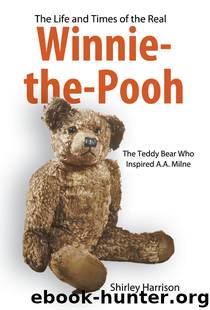The Life and Times of the Real Winnie-The-Pooh: The Teddy Bear Who Inspired A. A. Milne by Shirley Harrison

Author:Shirley Harrison [Harrison, Shirley]
Language: eng
Format: epub
Tags: General, Literary Criticism, Biography & Autobiography, European, Literary, English; Irish; Scottish; Welsh, Antiques & Collectibles, Children's Literature, JUVENILE NONFICTION / Biography & Autobiography / Literary, Toy Animals, Books
ISBN: 9781455614820
Publisher: Pelican Publishing
Published: 2011-07-01T07:18:55+00:00
Chapter Twelve
The Doldrums
ON 6 JANUARY 1930, Pooh took his first steps towards America. Literary agent Stephen Slesinger had arrived in London to visit the Milnes. He was a visionary and had recognised a new career for Pooh as a marketing figurehead. He purchased uS and Canadian merchandising, television, recording and other trade rights to the Winnie-the-Pooh works from Milne for a $1000 advance plus sixty-six per cent of Slesinger's income, so creating the first modern licensing industry.
Slesinger was recognised in America for his contribution to literacy for children and was highly commended as a well-known humanitarian for his work on behalf of youth, the pleasure he brought and the opportunities he furnished to those who might otherwise have been forgotten.
By November 1931, he had turned Pooh into a multi-million dollar a year business. Slesinger went on to market the bear and his friends for more than thirty years, creating the first Pooh look-alike toy bear, record, board game, puzzle, uS radio broadcast (NBC), animation, and motion picture film.
The first time Pooh appeared in colour was 1932, when he was drawn by Slesinger (not by Shepard or, as many people think, by Disney) in his now-familiar red shirt, and featured on an RCA Victor picture record. Parker Brothers also introduced A. A. Milne’s Winnie-the-Pooh Game in 1933, again with Pooh in his red shirt.
By 1935, the New York Times was reporting that Slesinger had seen in Pooh something that no one else had realised; that there was a place in industry for a genius with very little brain such as Winnie-the-Pooh. The likeness of Pooh could now been seen on spoons and forks, honey pots (spelt ‘hunny’) and not so surprisingly even on fever thermometers! Today there are dozens of spin-off publications, such as Pooh’s Workout Book, The Pooh Craft Book and The Pooh Baby Book. There are puzzle books and pop-up books. Slesinger’s marketing genius was to result over the years in the production of special jars of ‘Strengthening Medicine’, tea towels and crockery, money boxes, hot water bottles and woolly hats.
It was estimated that A.A. Milne was now making more money from manufacturers than from publishers.
For the next ten years Pooh and his now well-worn companions were safely resting in a glass case on a wall for an enforced (but fortunately, temporary) retirement. They became spectators, with an uncertain future.
There is no reliable evidence of their life or of their participation in the constantly escalating success of Milne’s four children’s books. No photographs exist of these years between. After chapter fourteen of eighteen in Ann Thwaite’s biography, their activities are not mentioned. In her follow-up chronicle of Milne’s work for children, The Brilliant Career of Winnie-the-Pooh (Methuen 1992), from 1931 they appear only by name in interviews given by A.A Milne and Daphne to the American press.
Daphne gave a lengthy interview to Parents magazine in America in April 1931, in which she paints all too clearly the less than happy state of the ageing toys in England. By 1931 Pooh, she regretted, was thinner and more shabby.
Download
This site does not store any files on its server. We only index and link to content provided by other sites. Please contact the content providers to delete copyright contents if any and email us, we'll remove relevant links or contents immediately.
How to Be a Bawse: A Guide to Conquering Life by Lilly Singh(7167)
Spare by Prince Harry The Duke of Sussex(4807)
Millionaire: The Philanderer, Gambler, and Duelist Who Invented Modern Finance by Janet Gleeson(4119)
Machine Learning at Scale with H2O by Gregory Keys | David Whiting(3673)
Harry Potter 02 & The Chamber Of Secrets (Illustrated) by J.K. Rowling(3561)
Never by Ken Follett(3552)
The Heroin Diaries by Nikki Sixx(3328)
Urban Outlaw by Magnus Walker(3251)
Harry Potter and the Prisoner of Azkaban (Book 3) by J. K. Rowling(3126)
Japanese Design by Patricia J. Graham(3008)
Fairy Tale by Stephen King(2978)
The Man Who Died Twice by Richard Osman(2824)
The Club by A.L. Brooks(2758)
Stacked Decks by The Rotenberg Collection(2701)
Will by Will Smith(2595)
Harry Potter and the Deathly Hallows (7) by J.K. Rowling(2556)
Churchill by Paul Johnson(2375)
The Chimp Paradox by Peters Dr Steve(2233)
Borders by unknow(2122)
